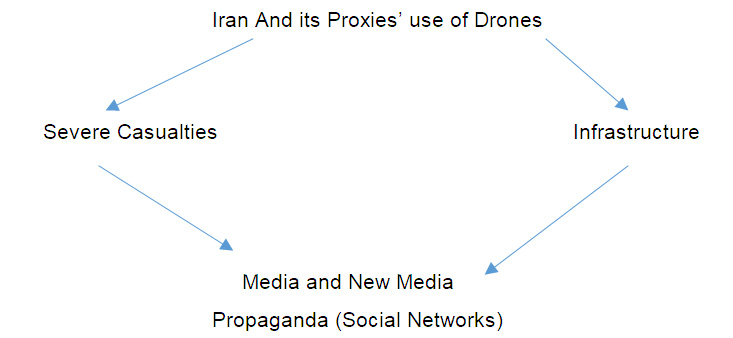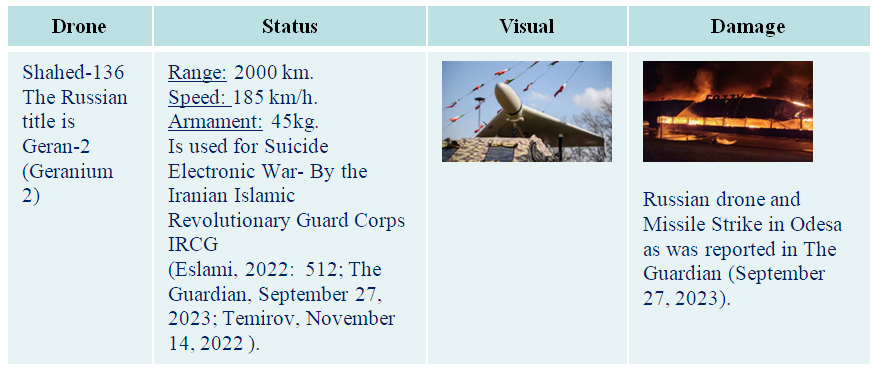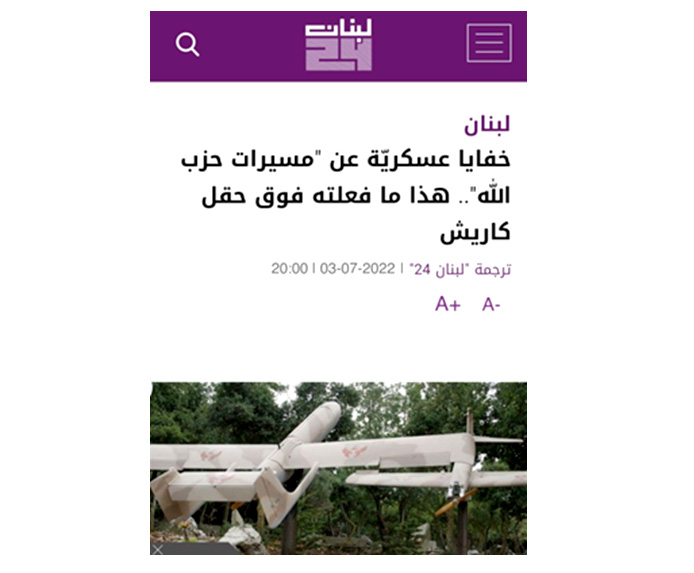The Iranian Involvement in the War in Ukraine and its Implication on Broader Arenas as the Middle-East - The Test Case of Unmanned Drones
(Volume 24, No. 3, 2023.)
Author: Dr. Barak Bouks, Bar Ilan university, Ramat Gan, Israel
DOI: https://doi.org/10.37458/nstf.24.3.7
Review paper
Received: November 11, 2023
Accepted: December 17, 2023
Abstract: The war in Ukraine introduced new methods of combat. Washington Policy institute notes that 2,000-2,400 drones were ordered from Iran, while being launched towards Ukrainian infrastructures as electricity, according to Kiev. Iran had also used unmanned drones targeting civilian population centers. Through feedback and military buildup, Iran implements the noted strategy in parallel arenas via proxies as Hezbollah in Lebanon.

Hezbollah had already threatened the Israeli gas rig Karish in July 2022. The noted combat drone tactics were implemented towards Israel in the Middle-Eastern arena, following the October 7th 2023 massacre and its subsequent war.
Keywords: Iran, Drones, The War in Ukraine, Hezbollah, The October 7th 2023 War.
Introduction:
The war in Ukraine is considered to be an ongoing conflict lasting over a year and a half. It is characterized by an involvement of external forces in the fighting, through consulting, experimenting and implementing new methods of combat, by systematically using drones, possessing an unmanned independent nature. Profits from drone sales are estimated according to a 4 billion US$ income until 2025, characterized in an ever-increasing sales pattern of 15-20% per year (Akrap & Kalinic, 2018). The initial case of illegal documented drone overflights above infrastructure in Europe, is attributed to France in 2014. Throughout a time series between October (5th, 19th & 31st) until November 13th, drones were spotted simultaneously in various distant locations of 13 nuclear plants (hundred miles apart) (Ranson, 2017). One may relate to the specific case of Iran as Revolutionary Guards' forces make use of the Ukrainian conflict for conducting advanced experiments designated to improve skills of unmanned drones aimed at infrastructure as electricity, and civilian population centers (Eslami, 2022: 507, 513; Temirov, November 14, 2022).
There is a linkage between a use of drones by Iranian proxies as Hezbollah as at the beginning of July 2022, when unmanned drones were launched towards the Israeli gas rig Karish, in order to signal Israel to accept Lebanon's terms for signing the new Maritime border between the countries (Lebanon 24, July 3, 2022). By launching unmanned Iranian drones towards Ukrainian infrastructures as electricity, we can notice a significant development of this method (The Washington Institute for Near East Policy notes that 2,000-2,400 drones were ordered from Iran, according to Kiev) (Knights & Almeida, 2022). Iran in that manner, is willing to intervene in distant conflicts in order to test new developments which can potentially pose a threat to the regional Middle-Eastern & Ukrainian arenas, yet, also to additional global arenas. Hence, the necessity to cooperate militarily in mutual monitoring of Iranian activities in several arenas, detailing its advancement in the realm of technology and share mutual information in order to meet this challenge.
This study will illuminate the Iranian involvement at the War in Ukraine and its implication on broader arenas as Lebanon in the Middle-East, by referring to the test case of unmanned drones via the following hypotheses:
Hypothesis I: Iran makes use of advanced technologies, as drones.
Hypothesis II: These drones serve as active weapons in conflict arenas, as the War in Ukraine or towards Israel from Lebanon.
Hypothesis III: Their designated task is: Surveillance, deterrence and developing destructive abilities, while the resulted impact is reported by the media and thus influences the general public. The data relating to these drones’ abilities is collected as feedback, serving for combat purposes as in Ukraine or following the October 7th 2023, massacre against Israel, subsequent by a regional war. Meeting the noted threats by development of interception technological techniques, is an imperative.
Theoretical Definitions:
While relating to the Iranian involvement in the war in Ukraine, we need to refer to some relevant studies, that can illuminate the rationale of states sponsoring terror. Scholars related to the support terror groups receive as ideology, budget, or training facilities, from states that sympathize with their cause and share an identical agenda (Piazza, 2008: 28-39).
Their targets are chosen thorough a decision-making process according to the probability that the terror groups' demands will be attained more effectively, and thus, the related attacks are considered as successful (Abrahams, 2006: 43-44; 2014, 11).
In that manner Iran uses drones in Ukraine or in Lebanon via its proxy Hezbollah, for purposes of a military power buildup & operating in active war arenas for enhancing combat abilities. Mass media worldwide, has a significant effect on a potential audience by relaying information to a general public through TV, radio and New Media channels (culminating with Facebook, Twitter, Instagram, etc.’). They serve as devices to channel a flow of information, hence a significant influence of the noted drone attacks reports (Bouks, 2021: 60).
Media reports serve for propaganda purposes, as they relate to the noted drones’ attacks, resulting with significant casualties and infrastructure damage, and thus, influence targeted audiences. In that manner launching rockets or drones, as was demonstrated by Hezbollah's attempt in November 10th, 2020, to launch a drone towards Israel was designated for intelligence and propaganda purposes (Andre & Ludvigsen, 2018: 26-49; Voice of Lebanon's official Tweeter page, November 11, 2022).
Figure 1: Relevant Test Cases:

Drones have been proven to be independent controlled vehicles, hence, challenging techniques and technologies of counter insurgency as software solutions, legislation relevant to imposing registration licensed devices while defining accountability to their operators, vis-à-vis banning their use in populated or restricted industrial or security areas (Akrap & Kalinic, 2018). Ranson (2017), referred to France's solutions following the 2014 drone incidents, as radar (Angelas), optics & electronics (Boreades), which can also be installed in a vehicle (SPID). Other countries offered additional solutions as the US. (a net based drone interceptor), or Israel (Drone Dome radar and camera-based detectors disrupting their electronic systems prior to an interception).
The War in Ukraine:
Following the outbreak of the war in Ukraine in February, 2022, Iran began to transfer hundreds of military drones to Russia. This alliance had a dual purpose from Russia an urgent necessity to widen its military operations, as from Iran this had provided an active war arena designated to improve its drone capabilities (Eslami, 2022: 507).
Table 1: Iranian Drones Used in the War in Ukraine:

Eslami, referred in a study published a year ago (2022: 513), to more than 100 drone operations in Odesa, Mykolaiv & Dnipropetrovsk. They were Iranian types: Shahed 136 & Shahed 131. Ukrainian air defense systems had proven some successful capabilities against Shahed-136 drones on October 5th & 9th 2022, attacks, as Russia launched some (Iranian) drones from Crimea & Kherson flying over 500 km into Ukrainian territory, towards Kiev (Eslami, 2022: 513; Temirov, 2022).
Temirov (2022), quoted Yurii Ihnat, a Ukrainian Air Force spokesman, referring to more than 400 Shahed 136’s Russian launches until November 9th, 2022. The Iranian combat rationale was elaborated as gaining influence in Central Asia (Note: The source located is Uzbekistan and thus relates to a local prism) (Lukash & Somalvi, 2022).
The Lebanese Test Case:
In 2021, it was estimated that Hezbollah had amassed about 2,000 drones following 15 years of buildup, as Iran also sponsored an independent manufacturing ability to the noted terror group (Wrobel, December 23, 2021). Hezbollah made use of these drones for surveillance and propaganda purposes: In July 7th 2020, Hezbollah launched a drone in Marj Ayoun (South Lebanon’s borer with Israel) for covering a victory video clip against Israel (Voice of Lebanon, July 7, 2022). Hezbollah made use of these drones for surveillance and propaganda purposes: In July 3rd, 2022, “Lebanon 24” website reported a penetration of Hezbollah’s drones towards “Karish” gas rig (on the previous day), while commenting the terror group intended for them to be discovered by Israel (Lebanon 24, July 3, 2022).
An official proclamation on October 1st, 2022, by Hezbollah’s secretary general Hassan Nasrallah on Hezbollah's formal TV's website, “Al-Manar”, branded this as a victory, emphasizing the main topic in a newsflash prior to the signature of the maritime border agreement between Israel-Lebanon. The noted report is one of a series of Hassan Nasrallah’s live speech’s transcription retrieved from TV: “Sayyed Nasrallah: Maritime victory is the fruit of the national solidarity and will help Lebanon cope with economic crisis” (“Al-Manar” website, October 1, 2022; Bouks, 2023: 129).
Following the outbreak of the October 7th 2023 massacre against Israel, which had been widened into a significant full-scale war against Hamas and Iranian proxies as Hezbollah (or the Yemenite Houthi Rebels), we can relate to several drone launches perpetrated by Hezbollah from Lebanon: On October 23rd, 2023, Hezbollah launched two drones crossing northern Israel (we can note a maritime cross of a single drone via the eastern Mediterranean towards the city of Acre) (Fabian, 2023).
The Reference form Lebanon 24, July 3, 2022

Hezbollah’s secretary general, Hassan Nasrallah, claimed responsibility for launching three suicide drones in this manner, on November 10th, 2023, following an alleged lethal Israeli strike against Hezbollah perpetrators in central Syria. He defined a Houthi suicide drone attack aimed at the Israeli city of Eilat a day before as "a great achievement" (Mroue, 2023). Two other drones were launched towards northern Israel also in the same manner, while causing sirens to be heard across all of the district. (Jerusalem Post Staff, November 20, 2023). Hezbollah launched another drone which was intercepted above the noted city of Acre (Following a series of sirens) (IDF Spokesperson, December 12, 2023). We can relate to a significant kamikaze drone launch towards a Northern Israel community of Margaliot, killing an IDF reservist soldier. In this attack the IDF succeeded in intercepting a second drone (Fabian & TOI Staff, 2023).
Note that while writing these lines Hezbollah did not refer yet, to any type of the noted drones.
Conclusions:
This study arrived at the following conclusions:
1. The Iranian drones were used simultaneously in several arenas.
2. The war in Ukraine provided Iran with an active arena to develop its drone core buildup via feedbacks (casualties, damages to infrastructure, culminating with the effect on the local population and authorities).
3. This has an effect on additional arenas Iran is operative in. One may arrive at a conclusion according to which a more active strategy is an imperative, as in meeting the noted drones’ combat abilities, by allocating budgets to existing US, France and Israeli projects, based on optics, electronics, radar-based disruption of drones, etc.'. Retrieved data from Ukrainian air defenses successes in meeting the noted challenge as well as Israeli IDF interceptions throughout the October 7th 2023 war, is significant in order to improve the noted technological abilities.
Cite this article:
APA 6th Edition
Bouks, B. (2023). The Iranian Involvement in the War in Ukraine and its Implication on Broader Arenas as the Middle-East - The Test Case of Unmanned Drones. National security and the future, 24 (3), 143-152. https://doi.org/10.37458/nstf.24.3.7
MLA 8th Edition
Bouks, Barak. "The Iranian Involvement in the War in Ukraine and its Implication on Broader Arenas as the Middle-East - The Test Case of Unmanned Drones." National security and the future, vol. 24, br. 3, 2023, str. 143-152. https://doi.org/10.37458/nstf.24.3.7
Chicago 17th Edition
Bouks, Barak. "The Iranian Involvement in the War in Ukraine and its Implication on Broader Arenas as the Middle-East - The Test Case of Unmanned Drones." National security and the future 24, br. 3 (2023): 143-152. https://doi.org/10.37458/nstf.24.3.7
Harvard
Bouks, B. (2023). 'The Iranian Involvement in the War in Ukraine and its Implication on Broader Arenas as the Middle-East - The Test Case of Unmanned Drones', National security and the future, 24(3), str. 143-152. https://doi.org/10.37458/nstf.24.3.7
Vancouver
Bouks B. The Iranian Involvement in the War in Ukraine and its Implication on Broader Arenas as the Middle-East - The Test Case of Unmanned Drones. National security and the future [Internet]. 2023 [pristupljeno: DD.MM.YYYY.];24(3):143-152. https://doi.org/10.37458/nstf.24.3.7
IEEE
B. Bouks, "The Iranian Involvement in the War in Ukraine and its Implication on Broader Arenas as the Middle-East - The Test Case of Unmanned Drones", National security and the future, vol.24, br. 3, str. 143-152, 2023. [Online]. https://doi.org/10.37458/nstf.24.3.7
Literature:
1. Lebanon 24 (Arabic), July 3, 2022.
2. Voice of Lebanon (Arabic), July 7, 2022, and November 11, 2022
3. Al-Manar Website (Arabic). October 1, 2022. Retrieved February 9, 2023, from https://www.almanar.com.lb/.
4. Abrahms, M. (2014). Deterring Terrorism: A New Strategy, Perspectives on Terrorism, 8(3), 2-15.
5. Abrahms, M. (2006). Why Terrorism Does Not Work, International Security, 31 (2), 42-78.
6. Akrap, G. & Kalinić, P. (2018). Unmanned Aerial Vehicles and Terrorism (Croatian), National Secuiry and the Future, 19 (1-2). Retrieved December 16, 2023. https://nsf-journal.hr/online-issues/focus/id/1251
7. Andre, J. & Ludvigsen, L. (2018). The Portrayal of Drones in Terrorist Propaganda: A Discourse Analysis of Al Qaeda in the Arabian Peninsula’s Inspire, Dynamics of Asymmetric Conflict, 11 (1), 26-49.
8. Bouks, B., (2023). Israel’s Strategic Threats and Challenges: Security, Influence & Cyber, Security Science Journal, 1, 119-133. http://securityscience.edu.rs/index.php/journal-security-science/article/view/99/69, DOI: 10.37458/ssj.4.1.8
9. Bouks, Barak, (2021). Conflict Coverage by Terror Move-ments’ Use of Mass Media and New Media – The Case of Irani Proxies: Hamas, Hezbollah and The Houthis, National Security and The Future, 3 (22), 59-71. DOI: https://doi.org/10.37458/nstf.22.3.4
10. IDF Spokesperson. (2023). Tuesday, Day Sixty-Seven of the War. War Diary 12/12 (Hebrew), IDF (Israel Defense Forces). Retrieved December 12, 2023. https://bit.ly/41i4R3X
11. Eslami, M. (2022). Iran’s Drone Supply to Russia and Changing Dynamics of the Ukraine War, Journal for Peace and Nuclear Disarmament, 5 (2), 507-518. DOI: https://www.tandfonline.com/doi/full/10.1080/25751654.2022.2149077
12. Fabian, E. (2023). IDF Intercepts Drones Over North, Foils Hezbollah Missile Squads, The Times of Israel. Retrieved October 23, 2023. https://www.timesofisrael.com/idf-intercepts-drones-over-north-foils-hezbollah-missile-squads/
13. Fabian, E. & TOI Staff. (2023) Reservist Soldier Killed as Hezbollah Kamikaze Drone Strikes Near Northern Town, The Times of Israel. Retrieved December 16, 2023. https://www.timesofisrael.com/apparently-explosive-laden-drone-launched-from-lebanon-strikes-near-northern-town/
14. Jerusalem Post Staff. (2023). Suspected Drones Launched from Lebanon After Israeli Strikes. The Jerusalem Post. Retrieved November 20, 2023. Available At: https://www.jpost.com/breaking-news/article-774147 (Downloaded: December 7, 2023).
15. Kaleji, V. (2022). Iran Opens Ababil-2 Drone Factory in Tajikistan: Reasons and Implications, Publication: Eurasia Daily Monitor, The Jamestown Foundations Global Research and Analysis, 19 (88). Retrieved June 14, 2022. https://jamestown.org/program/iran-opens-ababil-2-drone-factory-in-tajikistan-reasons-and-implications/
16. Knights, M. & Almeida, A. (2022). What Iran’s Drones in Ukraine Mean for the Future of War, The Washington Institute for Near East Policy. Retrieved November 10, 2022. https://www.washingtoninstitute.org/policy-analysis/what-irans-drones-ukraine-mean-future-war
17. Lukash, A. & Somfalvi, A. (2022). "Y-Net Morning Show" (Hebrew), Y Net. Retrieved March 3, 2022. https://www.youtube.com/watch?v=Urw5pxzbOrE
18. Mroue, B. (2023). Hezbollah Says It Is Introducing New Weapons in Ongoing Battles With Israeli Troops, AP. Retrieved November 11, 2023. https://apnews.com/article/lebanon-israel-hezbollah-nasrallah-gaza-burkan-drones-07701a32f07c172bccbf6bc6a3086ce8
19. Piazza, J.A., (2008). A Supply-Side View of Suicide Terror-ism: A Cross-National Study, The Journal of Politics, 70 (1), 28-39.
20. Ranson, A. (2017). The 2014 UAV Threat To French Nuclear Power Plants, National Security and the Future, 18 (1-2). Retrieved December 16, 2023. https://nsf-journal.hr/online-issues/case-studies/id/1227
21. Revealed: Europe’s Role in the Making of Russia Killer Drones, The Guardian. Retrieved September 27, 2023. https://www.theguardian.com/world/2023/sep/27/revealed-europes-role-in-the-making-of-russia-killer-drones
22. Temirov, R. (2022) Iranian Drones in Ukraine Put Spotlight on Tehran's Influence in Central Asia, Caravanserai. Retrieved No-vember 11, 2022. https://central.asia-news.com/en_GB/articles/cnmi_ca/features/2022/11/14/feature-01
23. Wrobel, S. (2021). Hezbollah Amassed 2,000 Drones as Part of Iran’s ‘UAV Army,’ Report Warns, Algemeiner. Retrieved De-cember 23. 2021. https://www.algemeiner.com/2021/12/23/hezbollah-amasses-2000-drones-as-iran-builds-uav-army-report-warns/